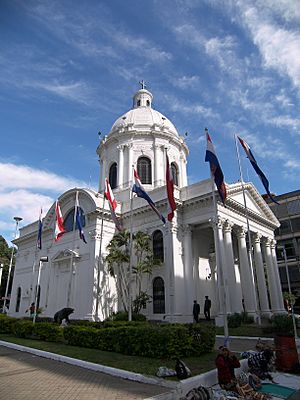National Pantheon of the Heroes facts for kids
The National Pantheon of the Heroes is a very important building and landmark in Asunción, Paraguay. Its full name is the National Pantheon of Heroes and Oratory of the Virgin of the Asuncion. This special place is in the center of Paraguay's capital city. People think it's a beautiful and important part of Paraguay's history and art.
Contents
How the Pantheon Was Built
The idea for this building started in October 1863. President Francisco Solano López asked an Italian architect, Alejandro Ravizza, to design a chapel. But a big war, the War of the Triple Alliance, stopped the work. The building stayed unfinished for more than 70 years! It was finally completed and opened on October 12, 1936. This happened after another war, the Chaco War. Then, it officially became the National Pantheon of Heroes.
A Place for Heroes
The National Pantheon is like a special tomb, called a mausoleum. It's where many important people from Paraguay's history are buried. You can find the remains of Carlos Antonio López, who was Paraguay's first constitutional president. Also, Francisco Solano López rests here. José Félix Estigarribia, a hero from the Chaco War, and his wife are also buried here. The Pantheon also honors the child martyrs of Acosta Ñu and two Unknown Soldiers.
Special Features and Traditions
Inside the Pantheon, you can see many special plaques. These plaques were sent by leaders, kings, and princes from other countries. They show respect and congratulations to Paraguay. On the front of the Pantheon, there's a Latin phrase: "Fides et Patria." This means "My faith and my country."
When something big and historic happens in Asunción, like a major election victory, people often gather outside the Pantheon. They celebrate in the street with their flags. It's a tradition to mark important moments here. Also, there's a special ceremony where the guards change several times a day.
Gallery
See also
 In Spanish: Panteón Nacional de los Héroes para niños
In Spanish: Panteón Nacional de los Héroes para niños





